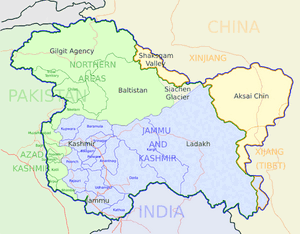Ladakh
| Author:Laxman Burdak, IFS (Retd.) |

Ladakh (Hindi: लद्दाख़; Ladakhi: ལ་དྭགས ; Urdu: لَدّاخ) is a region in Indian state of Jammu and Kashmir. Lit. meaning "land of high passes". It is one of the most sparsely populated regions in Jammu and Kashmir and its culture and history are closely related to that of Tibet.
Variants of name
- Laddakh
- Laddākh
- La-dvags/la'dwags (Tibetan)
- Lalataksha/Lalāṭāksha (ललाटाक्ष) Mahabharata (II.47.15),
- Lalatapura
- Lalāṭapura
Location
Ladakh is the highest plateau in the state of Jammu & Kashmir with much of it being over 3,000 m. It currently extends from the Kunlun mountain range to the main Great Himalayas to the south, inhabited by people of Indo-Aryan and Tibetan descent. Historically, the region included the Baltistan (Baltiyul) valleys (now mostly in Pakistan), the entire upper Indus Valley, the remote Zanskar, Lahaul and Spiti to the south, much of Ngari including the Rudok region and Guge in the east, Aksai Chin in the northeast (extending to the Kun Lun Mountains), and the Nubra Valley to the north over Khardong La in the Ladakh Range. Contemporary Ladakh borders Tibet to the east, the Lahaul and Spiti regions to the south, the Vale of Kashmir, Jammu and Baltiyul regions to the west, and the southwest corner of Xinjiang across the Karakoram Pass in the far north.
History
V. S. Agrawala[1] writes that Panini mentions Pura (IV.2.122) ending names of towns like Lalatapura (Lalāṭapura) - probably in the region called Lalāṭāksha, modern Ladakh, Sabhaparva (47.15)
Rock carvings found in many parts of Ladakh indicate that the area has been inhabited from Neolithic times.[2] Ladakh's earliest inhabitants consisted of a mixed Indo-Aryan population of Mons and Dards,[3] who find mention in the works of Herodotus, who mentions twice a people called Dadikai, first along with the Gandarioi, and again in the catalogue of king Xerxes's army invading Greece. Herodotus also mentions the gold-digging ants of Central Asia.
Pliny, In the 1st century, repeats that the Dards were great producers of gold.
Ptolemy situates the Daradrai on the upper reaches of the Indus.
Dards find mention by Nearchus, Megasthenes and in the geographical lists of the Puranas.[4] Around the 1st century, Ladakh was a part of the Kushana empire.
Buddhism spread into western Ladakh from Kashmir in the 2nd century when much of eastern Ladakh and western Tibet was still practising the Bon religion. The 7th century Buddhist traveler Xuanzang describes the region in his accounts. [5] Xuanzang describes a journey from Ch'u-lu-to (Kuluta, Kullu) to Lo-hu-lo (Lahul), then goes on saying that "from there to the north, for over 2000 li, the road is very difficult, with cold wind and flying snow"; thus one arrives in the kingdom of Mo-lo-so, or Mar-sa, synonymous with Mar-yul, a common name for Ladakh. Elsewhere, the text remarks that Mo-lo-so, also called San-po-ho borders with Suvarnagotra or Suvarnabhumi (Land of Gold), identical with the Kingdom of Women (Strirajya). According to Tucci, the Zan-zun kingdom, or at least its southern districts were known by this name by the 7th century Indians.
Ladakh is renowned for its remote mountain beauty and culture. Aksai Chin is one of the disputed border areas between China and India.[6] It is administered by China as part of Hotan County but is also claimed by India as a part of the Ladakh region of the state of Jammu and Kashmir. In 1962, China and India fought a brief war over Aksai Chin and Arunachal Pradesh, but in 1993 and 1996 the two countries signed agreements to respect the Line of Actual Control.[6]
In the past Ladakh gained importance from its strategic location at the crossroads of important trade routes,[7] but since the Chinese authorities closed the borders with Tibet and Central Asia in the 1960s, international trade has dwindled except for tourism. Since 1974, the Government of India has successfully encouraged tourism in Ladakh. Since Ladakh is a part of strategically important Jammu and Kashmir, the Indian military maintains a strong presence in the region.
The largest town in Ladakh is Leh, followed by Kargil.[8] Almost half of Ladakhis are Shia Muslims and the rest are mostly Tibetan Buddhists.[9]
In terms of pronunciation, the use of ..."Ladakh, the Persian transliteration of the Tibetan La-dvags, is warranted by the pronunciation of the word in several Tibetan districts."[10]
In Mahabharata
Sabha Parva, Mahabharata/Book II Chapter 47 mentions the Kings who brought tributes to Yudhishthira. It includes Latataksha:
- थव्यक्षांस तर्यक्षाँल ललाटाक्षान नानाथिग्भ्यः समागतान
- औष्णीषान अनिवासांश च बाहुकान पुरुषाथकान Mahabharata (II.47.15)
External links
References
- ↑ V. S. Agrawala: India as Known to Panini, 1953, p.64
- ↑ Loram, Charlie (2004) [2000]. Trekking in Ladakh (2nd ed.). Trailblazer Publications.
- ↑ Ray, John (2005). Ladakhi Histories — Local and Regional Perspectives. Leiden, Netherlands: Koninklijke Brill NV.
- ↑ Petech, Luciano (1977). The Kingdom of Ladakh c. 950–1842 A.D. Istituto Italiano per il media ed Estremo Oriente.
- ↑ See The Kingdom of Ladakh c. 950–1842 A.D., Istituto Italiano per il media ed Estremo Oriente, 1977.
- ↑ "India-China Border Dispute". GlobalSecurity.org.
- ↑ Rizvi, Janet (2001). Trans-Himalayan Caravans – Merchant Princes and Peasant Traders in Ladakh. Oxford India Paperbacks.
- ↑ Osada et al. (2000), p. 298.
- ↑ Rizvi, Janet (1996). Ladakh — Crossroads of High Asia. Oxford University Press.
- ↑ Francke(1926) Vol. I, p. 93, notes.

